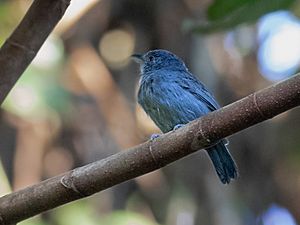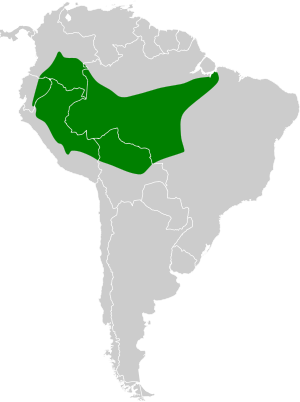Plain-winged antshrike facts for kids
Quick facts for kids Plain-winged antshrike |
|
|---|---|
 |
|
| Conservation status | |
| Scientific classification | |
| Genus: |
Thamnophilus
|
| Species: |
schistaceus
|
 |
|
The plain-winged antshrike (Thamnophilus schistaceus) is a small bird that lives in the Amazon rainforest. It belongs to a family of birds called Thamnophilidae, which are often found in Central and South America. This bird gets its name from its plain-looking wings and its habit of hunting insects, much like a shrike.
You can find the plain-winged antshrike in several South American countries. These include Bolivia, Brazil, Colombia, Ecuador, and Peru. It prefers to live in warm, wet places.
Contents
Where Does the Plain-winged Antshrike Live?
The plain-winged antshrike's home is usually in specific types of forests. Its natural habitats are subtropical or tropical moist lowland forests. These are forests that are not too high up and get a lot of rain.
Forest Homes
These birds also live in subtropical or tropical swamps. Swamps are wet, forested areas that are often flooded. The plain-winged antshrike likes these places because they offer plenty of trees and plants for shelter and food. They are often found in the undergrowth, which is the dense layer of plants and shrubs below the main tree canopy.
What Does the Plain-winged Antshrike Look Like?
The plain-winged antshrike is a medium-sized bird for its family. It has a rather simple appearance, which helps it blend into its forest home.
Male and Female Differences
Male plain-winged antshrikes typically have a slate-gray or bluish-gray color. Their wings are a uniform color, which is how they got the "plain-winged" part of their name. Females often have a slightly different look. They might have a browner or more olive color, especially on their back and wings. This difference in color between males and females is common in many bird species.
Size and Shape
These birds are usually about 14 to 16 centimeters (about 5.5 to 6.3 inches) long. They have a sturdy body and a strong, hooked bill. This type of bill is perfect for catching and holding onto insects, which are a big part of their diet.
What Does the Plain-winged Antshrike Eat?
Like many birds in its family, the plain-winged antshrike is an insectivore. This means its main diet consists of insects.
Hunting for Food
It spends its time searching for insects among the leaves and branches of trees and shrubs. It might also catch spiders and other small invertebrates. These birds are very good at finding hidden prey. They often move slowly and carefully through the vegetation, looking for their next meal.
How Does the Plain-winged Antshrike Behave?
The plain-winged antshrike is generally a shy bird. It prefers to stay hidden within the dense forest.
Calls and Songs
These birds communicate using various calls. Their songs are often simple but distinct, helping them to find mates or mark their territory. Birdwatchers often identify them by their unique sounds rather than by seeing them.
Social Life
Plain-winged antshrikes are usually seen alone or in pairs. They are not known to form large flocks. They might sometimes join mixed-species foraging flocks. These are groups of different bird species that travel and hunt for food together. This can help them find more food and stay safer from predators.
Reproduction and Life Cycle
Like all birds, plain-winged antshrikes lay eggs to reproduce. They build nests to raise their young.
Nesting Habits
Their nests are typically cup-shaped and built in the forks of trees or shrubs. They use plant materials like twigs, leaves, and fibers to construct a safe place for their eggs. Both the male and female birds likely help with building the nest and raising the chicks.
Eggs and Chicks
Female antshrikes usually lay a small number of eggs, often two or three. The eggs are incubated, meaning the parents sit on them to keep them warm until they hatch. Once the chicks hatch, they are fed by their parents until they are old enough to fly and find food on their own.
Is the Plain-winged Antshrike Endangered?
The plain-winged antshrike is currently listed as "Least Concern" by the International Union for Conservation of Nature (IUCN). This means that its population is stable and not at high risk of becoming extinct.
Why "Least Concern"?
This status is good news! It means that the plain-winged antshrike is still common in its habitat. Its wide range across several countries and its ability to live in different types of forests contribute to its stable population. However, protecting its forest homes is still important for its long-term survival.
See also
 In Spanish: Batará alillano para niños
In Spanish: Batará alillano para niños


